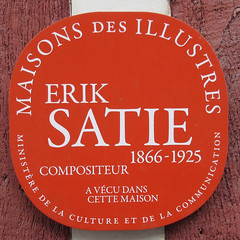Erik Satie
Commemorated on 3 plaques
Erik Satie compositeur de musique a vecu dans cette maison de 1890 a 1898
English translation: Erik Satie music composer saw in this house from 1890 to 1898 [AWS Translate]
6 Rue Cortot, Paris, France where they lived
Erik Satie, 1866-1925, compositeur, a vécu dans cette maison.
English translation: Erik Satie, 1866-1925, composer, lived in this house.
90 rue Haute, Honfleur, France where they lived
Dans l'effervescence créatrice des années 1920, l'hôtel Istria accueillit, entre autres artistes, Francis Picabia, Marcel Duchamp, Moïse Kisling, peintres, Man Ray, photographe, Kiki de Montparnasse, modèle et égérie, Erik Satie, compositeur, Rainer Maria Rilke, Tristan Tzara, Vladimir Maïakovski, poètes, et Louis Aragon qui y rejoignait Elsa Triolet. "Ne s'éteint que ce qui brilla ... Lorsque tu descendais de l'hôtel Istria, Tout était différent Rue Campagne Première, En mil neuf cent vingt neuf , vers l'heure de midi ..." Louis Aragon (Il ne m'est Paris que d'Elsa.)
English translation: In the creative effervescence of the 1920s, Hotel Istria welcomed, among other artists, Francis Picabia, Marcel Duchamp, Moïse Kisling, painters, Man Ray, photographer, Kiki de Montparnasse, model and mighty, Erik Satie, composer, Rainer Maria Rilke, Tristan Tzara, Vladimir Maiakovski, poets, and Louis Aragon who joined there Elsa Triolet. “Only that which shone... When you came down from the Hotel Istria, Everything was different in Rue Campagne Première, in 1929, around noon...” Louis Aragon (I'm Paris only from Elsa.)
29 rue Campagne-Première, Paris, France where they worked




